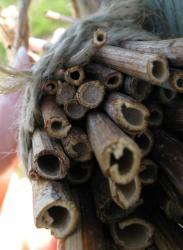Gleni said:I am going to get a native bee hive in spring. They are a bit exxy at $400 though.
Your likely thinking of Mason Bee or Blue Orchard Bee hives they sell commercially? 400 is an awful lot unless you have a whole orchard you need pollinated. O_o (Likely way to obvious but I gota say just in case: No honeybee is native to North America, they are all from Europe or Africa and such, brought over by settlers for the honey, so if you are getting a honey producing hive advertized as "native" your being duped big time. There are plenty of FERAL honeybees, but no "native" ones...and the fact our native bees are more efficient at pollinating most crops is another topic :P )
Our native bees are quite happy with free ones...maintenance is much easier and you do not have to sterilize them each year either. I cringe at 99% of the houses sold these days (to people who don't know or don't care to clean and maintain them) as they are nearly impossible to clean and will become disease and parasite factories...not helping the local population at all in the end.
I make them our of last years plant stems, of plants that have hollow stems....like the invasive Phragmities, just be sure not to take any seeds!!!!). Chop them into 6 to 9 inch lengths with a leaf joint at one end (it has a natural close there) bundle together and place in a spot that gets nice morning sun. Bees will fill it up before you know it. and having a natural product with a variate of hole sizes will allow multiple species to use it. Each native bee species is a different size and can only use a hole that "fits" her, so 'houses' with only one size hole will only host one species and here in eastern Canada we have OVER 500 species of native bees. For a home gardener a few bundles scattered throughout the yard is perfectly adequate to help the local bees. I love some of the new designs that are like bird houses without the front (like the one in the article below). Then just cycle them out each year and no parasite or disease build up. Yay. Put the bundles from last year in an "emerging chamber" (can be a box or a bucket or anything really) that has a hole for the emerging bees to go out of but hides the bundle itself so it is not reused, and make sure you have the new stem bundle out for them to use this year.
 http://nativeplantwildlifegard...
http://nativeplantwildlifegard...
Also 70% of our native bees nest in the ground...only about 30% are cavity nesters.
A pic of one of my small bundles from a few years ago, had residents shortly after I put it out (you can tell from the mud closing the entrances, those are now full of eggs and will emerge as adults the next spring).

As to the original topic: I totally agree, Neonicotianoids are some of the scariest things mass used right now....no excuse for the excessive use....
